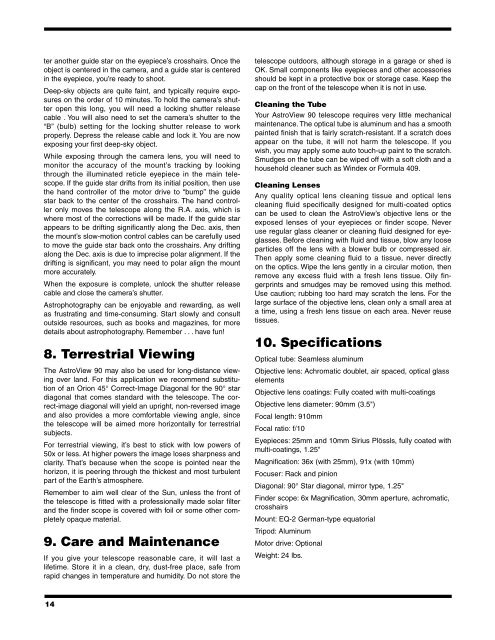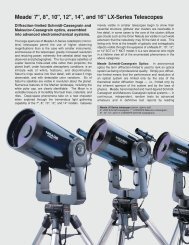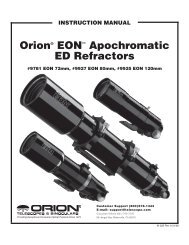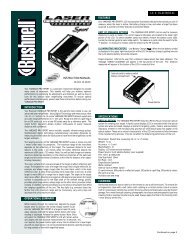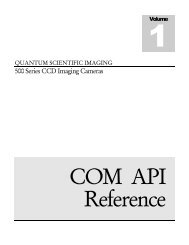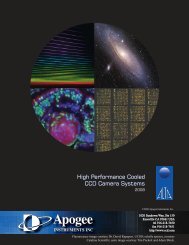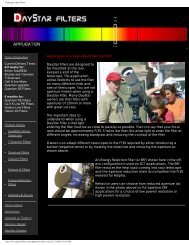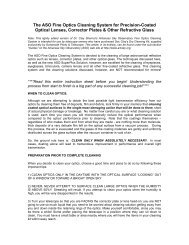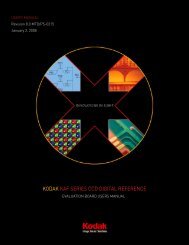Orion AstroView 90 EQ Instructions - Oceanside Photo and Telescope
Orion AstroView 90 EQ Instructions - Oceanside Photo and Telescope
Orion AstroView 90 EQ Instructions - Oceanside Photo and Telescope
You also want an ePaper? Increase the reach of your titles
YUMPU automatically turns print PDFs into web optimized ePapers that Google loves.
ter another guide star on the eyepiece’s crosshairs. Once the<br />
object is centered in the camera, <strong>and</strong> a guide star is centered<br />
in the eyepiece, you’re ready to shoot.<br />
Deep-sky objects are quite faint, <strong>and</strong> typically require exposures<br />
on the order of 10 minutes. To hold the camera’s shutter<br />
open this long, you will need a locking shutter release<br />
cable . You will also need to set the camera’s shutter to the<br />
“B” (bulb) setting for the locking shutter release to work<br />
properly. Depress the release cable <strong>and</strong> lock it. You are now<br />
exposing your first deep-sky object.<br />
While exposing through the camera lens, you will need to<br />
monitor the accuracy of the mount’s tracking by looking<br />
through the illuminated reticle eyepiece in the main telescope.<br />
If the guide star drifts from its initial position, then use<br />
the h<strong>and</strong> controller of the motor drive to “bump” the guide<br />
star back to the center of the crosshairs. The h<strong>and</strong> controller<br />
only moves the telescope along the R.A. axis, which is<br />
where most of the corrections will be made. If the guide star<br />
appears to be drifting significantly along the Dec. axis, then<br />
the mount’s slow-motion control cables can be carefully used<br />
to move the guide star back onto the crosshairs. Any drifting<br />
along the Dec. axis is due to imprecise polar alignment. If the<br />
drifting is significant, you may need to polar align the mount<br />
more accurately.<br />
When the exposure is complete, unlock the shutter release<br />
cable <strong>and</strong> close the camera’s shutter.<br />
Astrophotography can be enjoyable <strong>and</strong> rewarding, as well<br />
as frustrating <strong>and</strong> time-consuming. Start slowly <strong>and</strong> consult<br />
outside resources, such as books <strong>and</strong> magazines, for more<br />
details about astrophotography. Remember . . . have fun!<br />
8. Terrestrial Viewing<br />
The <strong>AstroView</strong> <strong>90</strong> may also be used for long-distance viewing<br />
over l<strong>and</strong>. For this application we recommend substitution<br />
of an <strong>Orion</strong> 45° Correct-Image Diagonal for the <strong>90</strong>° star<br />
diagonal that comes st<strong>and</strong>ard with the telescope. The correct-image<br />
diagonal will yield an upright, non-reversed image<br />
<strong>and</strong> also provides a more comfortable viewing angle, since<br />
the telescope will be aimed more horizontally for terrestrial<br />
subjects.<br />
For terrestrial viewing, it’s best to stick with low powers of<br />
50x or less. At higher powers the image loses sharpness <strong>and</strong><br />
clarity. That’s because when the scope is pointed near the<br />
horizon, it is peering through the thickest <strong>and</strong> most turbulent<br />
part of the Earth’s atmosphere.<br />
Remember to aim well clear of the Sun, unless the front of<br />
the telescope is fitted with a professionally made solar filter<br />
<strong>and</strong> the finder scope is covered with foil or some other completely<br />
opaque material.<br />
9. Care <strong>and</strong> Maintenance<br />
If you give your telescope reasonable care, it will last a<br />
lifetime. Store it in a clean, dry, dust-free place, safe from<br />
rapid changes in temperature <strong>and</strong> humidity. Do not store the<br />
telescope outdoors, although storage in a garage or shed is<br />
OK. Small components like eyepieces <strong>and</strong> other accessories<br />
should be kept in a protective box or storage case. Keep the<br />
cap on the front of the telescope when it is not in use.<br />
Cleaning the Tube<br />
Your <strong>AstroView</strong> <strong>90</strong> telescope requires very little mechanical<br />
maintenance. The optical tube is aluminum <strong>and</strong> has a smooth<br />
painted finish that is fairly scratch-resistant. If a scratch does<br />
appear on the tube, it will not harm the telescope. If you<br />
wish, you may apply some auto touch-up paint to the scratch.<br />
Smudges on the tube can be wiped off with a soft cloth <strong>and</strong> a<br />
household cleaner such as Windex or Formula 409.<br />
Cleaning Lenses<br />
Any quality optical lens cleaning tissue <strong>and</strong> optical lens<br />
cleaning fluid specifically designed for multi-coated optics<br />
can be used to clean the <strong>AstroView</strong>’s objective lens or the<br />
exposed lenses of your eyepieces or finder scope. Never<br />
use regular glass cleaner or cleaning fluid designed for eyeglasses.<br />
Before cleaning with fluid <strong>and</strong> tissue, blow any loose<br />
particles off the lens with a blower bulb or compressed air.<br />
Then apply some cleaning fluid to a tissue, never directly<br />
on the optics. Wipe the lens gently in a circular motion, then<br />
remove any excess fluid with a fresh lens tissue. Oily fingerprints<br />
<strong>and</strong> smudges may be removed using this method.<br />
Use caution; rubbing too hard may scratch the lens. For the<br />
large surface of the objective lens, clean only a small area at<br />
a time, using a fresh lens tissue on each area. Never reuse<br />
tissues.<br />
10. Specifications<br />
Optical tube: Seamless aluminum<br />
Objective lens: Achromatic doublet, air spaced, optical glass<br />
elements<br />
Objective lens coatings: Fully coated with multi-coatings<br />
Objective lens diameter: <strong>90</strong>mm (3.5")<br />
Focal length: 910mm<br />
Focal ratio: f/10<br />
Eyepieces: 25mm <strong>and</strong> 10mm Sirius Plössls, fully coated with<br />
multi-coatings, 1.25"<br />
Magnification: 36x (with 25mm), 91x (with 10mm)<br />
Focuser: Rack <strong>and</strong> pinion<br />
Diagonal: <strong>90</strong>° Star diagonal, mirror type, 1.25"<br />
Finder scope: 6x Magnification, 30mm aperture, achromatic,<br />
crosshairs<br />
Mount: <strong>EQ</strong>-2 German-type equatorial<br />
Tripod: Aluminum<br />
Motor drive: Optional<br />
Weight: 24 lbs.<br />
14


